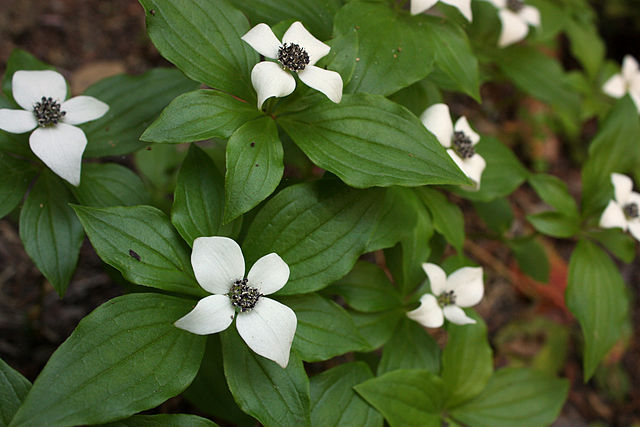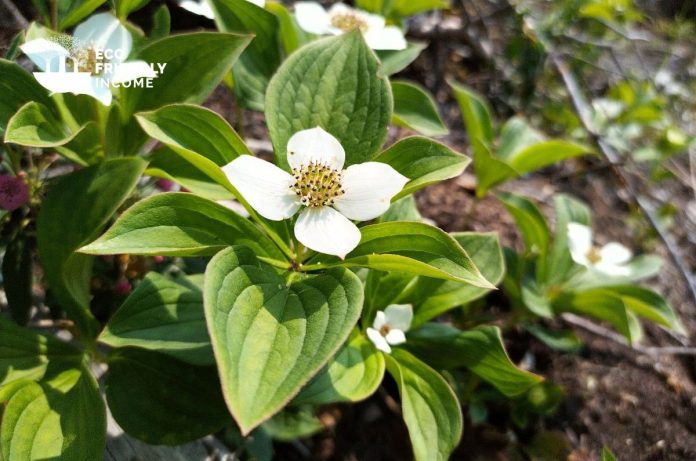One of the wild plants I’m most familiar with, it grows all over our family acreage. They’re pretty common once you’re in the boreal forest, and identifying bunchberry (Cornus canadensis) is pretty easy.
Bunchberry, or creeping dogwood, is a gorgeous plant almost all year long. You can see its beautiful white flowers in the spring, followed by bright red berries mid to late summer. In the fall, the green leaves slowly fade into a lovely burgundy color.
It has some medicinal uses that can become handy to the curious, and the berries can make special jams.
As a tree planter in the boreal forest, I’ve seen bunchberry countless times. My favorite time to see them is during early spring, oftentimes I stumble upon a whole forest floor covered with their striking white flowers.
Despite this plant being so common in my area, doesn’t mean I shouldn’t be thoughtful when harvesting it. When I forage for this berry, I really try to pick it sustainably, and I think everyone should.
Birds and mammals alike snack on this plant, it wouldn’t be fair to go out and pluck them all out. They might just not come back in the following years.
Here’s what you can expect to learn in this article:
- Bunchberry Picking Season
- How to Identify Bunchberry
- Where You Can Find it
- How to Harvest it Sustainably
- How to Propagate Bunchberry
- How to Store it
Let’s get started!
Bunchberry Picking Season
Bunchberry has different picking seasons depending on what you’re after.
You might want to pick the flowers for their fragrance, the fruits for nutritive value, or the leaves for their medicinal properties.
Flower Picking Season
- May to June
Fruit Picking Season
- June to September
Are Bunchberries edible?
The answer is yes! Bunchberries are edible, although they have a very mild flavor that’s between sweet and sour.
Raw bunchberries are slightly dry and mealy. The best way to eat them is dehydrated to concentrate the sugars or by using their high pectin content to make jams.
How to Identify Bunchberry (Cornus canadensis)
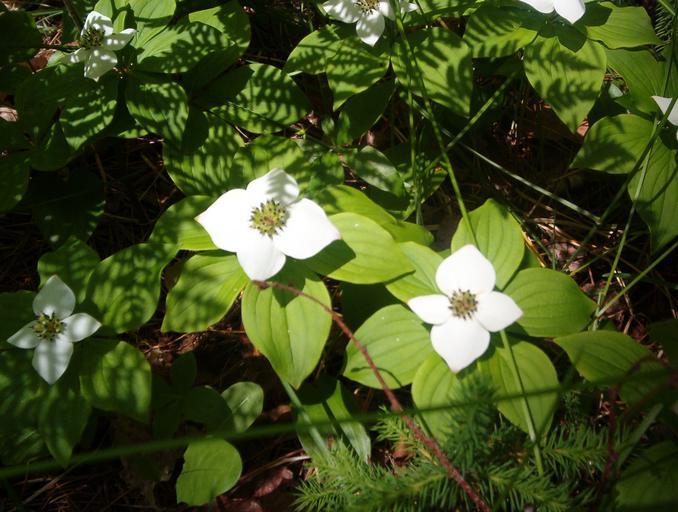
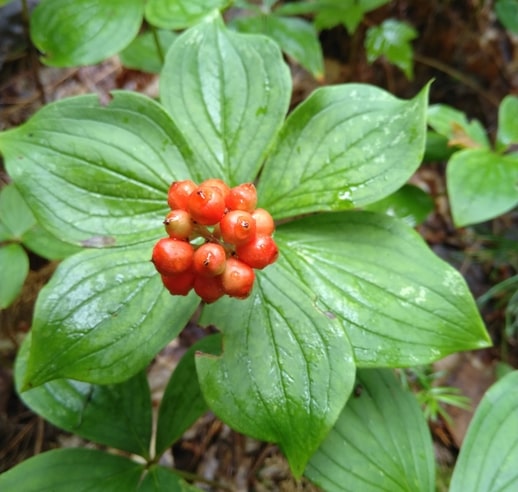
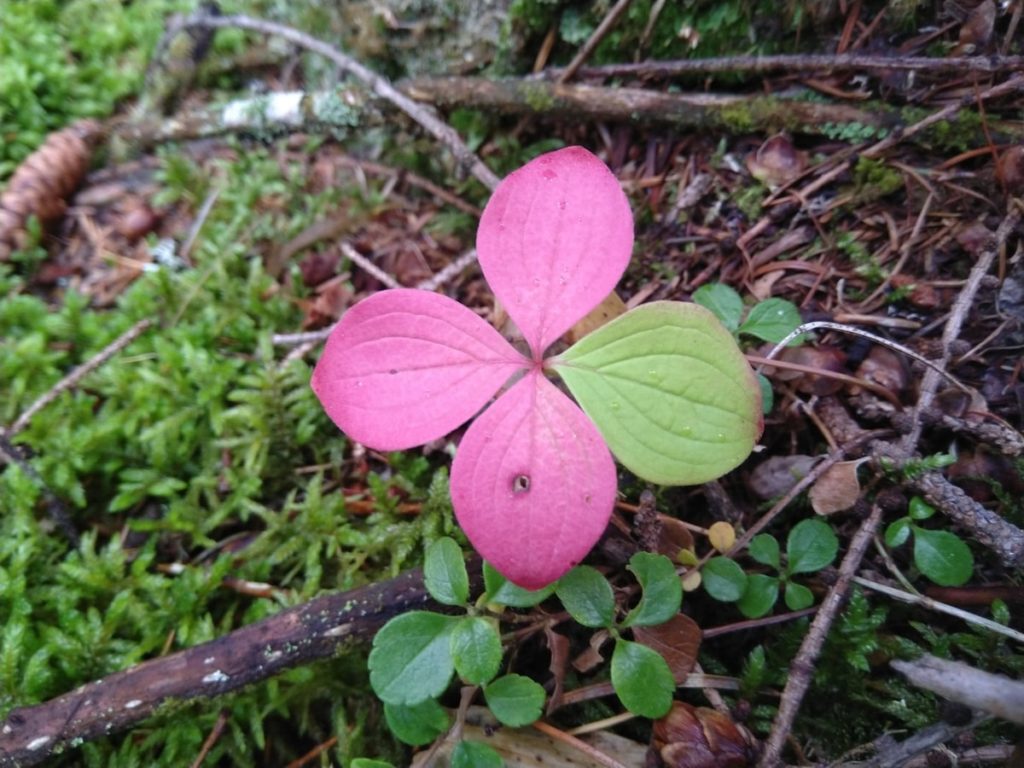
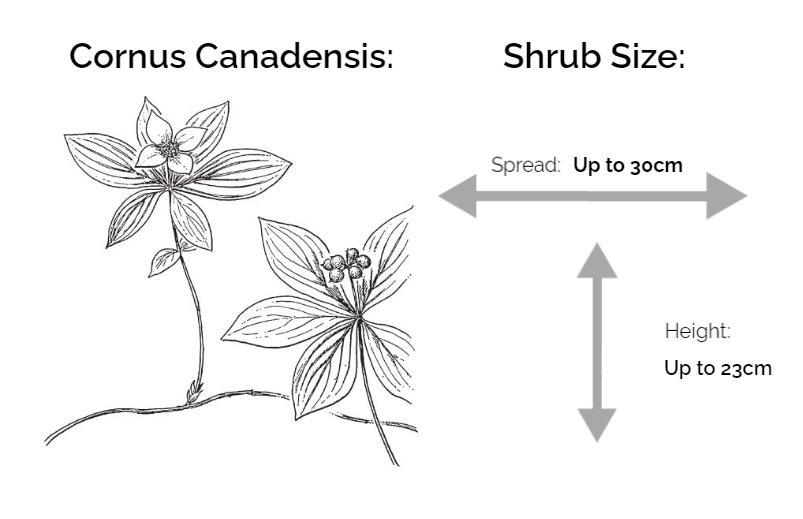
Bunchberry (Cornus Canadensis) is a beautiful herbaceous plant with 4 to 6 egg-shaped (ovate) to inversely egg-shaped (obovate) leaves, with entire margins that grow in a whorl arrangement.
At the center of each leaf bundle grows a stem that produces single, but splendid 4 to 6 white-petalled flowers. Later in the season, this stem produces bunches of bright red berries.
Bunchberry has 2-7cm leaves with a slight gloss to them and showy vein structures.
They spread through the forest floor by rhizomes and quickly grow into large colonies.
Where You Can Find Bunchberry Plants
Bunchberry’s favorite habitat is mixed-wood forests, in cool and moist environments.
In my experience, they often grow under tree plantations or shaded forest floors.
They’ll grow in areas with slightly acidic to very acidic soil. I’ve most often seen them grow in drier soils, not overly wet or swampy. An older deciduous forest might be a great spot to look for bunchberry.
At home, our greatest bunchberry colony grows under a jackpine tree plantation.
It grows all over North America and even around the globe in Northern Asia and Europe.
I’ve seen Bunchberry grow near the following plants:
- Threeleaf Goldthread (Coptis trifolia)
- Bluebead (Clintonia Borealis)
- White Pine (Pinus strobus) & Jack Pine (Pinus banksiana)
- Fiddlehead Fern (Matteuccia struthiopteris)
When you see any of these, there’s a good chance bunchberry might be somewhere close.
How to Harvest Bunchberry Plants Sustainably
Since this plant is loved by wildlife, you want to be very thoughtful of each shrub when you pick.
My personal method for picking bunchberry sustainably:
- Pick a plant that has enough neighbors (leave the single plants alone)
- Collect only a few berries per plant, or one flower per 3 plants.
- Move on to the next plant
It’s simple, taking fewer flowers or berries will minimally impact the colony, and they’ll keep propagating.
Something else I like to do when I see the red fruits is to toss some on the ground and cover them with a bit of forest litter.
You don’t need to bury them, they need to go through natural stratification. The best way to help them is to cover them with leaf litter, then they’ll have a better chance to germinate next spring.
How to Propagate Bunchberry (Cornus canadensis)

Hardiness Zone: 2-7

Soil Type: Well-drained, sand, clay, peat.

Water: Normal. Fair Drought tolerance.

Exposure: Full Sun to Partial Shade
Bunchberry (Cornus canadensis) is a herbaceous shrub hardy up to zone 2. A bunchberry plant should be planted in a well-drained mix of sand and peat. The best spot is a shady area and you should water it weekly to make sure it retains moisture, especially when flowering.
Commercial Value
Propagating bunchberry might have merit commercially.
They are very rare to find in gardening centers yet they make beautiful landscaping plants. Since they love shade, they are wonderful to plant in beds under older trees.
Bunchberry fruits used to be picked by our ancestors, which preserved them for winter. They made jams and dried fruit out of them. The flowers are also nutritious and can be added to salads.
If you can manage to turn them into delicious snacks, they might sell reasonably well at farmer’s markets.
Growing and propagating bunchberry is possible if you have the right environment.
The Best Way to Propagate Bunchberry Plants:
Division
Bunchberry likes to spread by stolon and rhizome, which make them easy to propagate by division.
Here’s how to do it:
- Find a wild patch of bunchberry and identify the largest plants.
- Look closely to see the vines going away from the mother plants.
- Carefully pull a vine up from the ground, you’ll see some parts are attached to the ground by root.
- It should lead you to a clone further down, now all you need to do is dig it out.
- Snip the vine to seperate the clone, then keep moist until you transplant.
- When you transplant, you want to remove any dead or diseased foliage.
- Pot them individually and water thoroughly until they are established.
The best time to divide bunchberry plants is during spring or early summer. If you’re growing them outdoors then they’ll have time to establish themselves before the winter.
Be cautious to divide bunchberry only before or after blooming, not during. Blooming takes a lot of energy from the plant, it’s not a good time to stress it at that point.
Sowing
You can also propagate bunchberry by sowing its seeds.
Seeds are available online or if you got wild plants, you can extract the seeds from them.
The seeds hide within their fruits, which appear during late summer. Here’s how you can extract the seeds:
How to Extract bunchberry seeds from Fruits
Step 1: Collect bunchberry fruits, then add to blender, fill water up to 3/4 full.
Step 2: Blend the fruits, and let the mixture rest. Bunchberry seeds will sink to the bottom.
Step 3: Scoop out the pulp at the top, then drain the mixture into a screen.
Step 4: Now you can just handpick your seeds, and let them dry on a paper towel.
Note: Bunchberry seeds need a warm-cold stratification process to germinate. For that, you need to put them in a ziplock bag with moist sand for 40 days at room temperature, and 140 days moist-cold stratification in the refrigerator.
How to Sow Bunchberry Seeds
The best-growing medium for your bunchberry seeds is peat moss. Just sprinkle the seeds evenly on top and cover them with a thin layer (1/4 inch) of soil. Cover to keep the moisture levels high but too wet or soggy.
Wild bunchberry seeds should be fully germinated within a month!
When they’ve grown enough for transplanting, do it carefully as the roots aren’t very solid at this stage.
For this stage, the best-growing medium is peat moss mixed with sand and perlite.
How to Store Freshly Picked Bunchberry
There are two ways you can store fresh bunchberry, you can dehydrate them or freeze them.
You can get a small dehydrator online for about $100 that will do a good job. It’s a good investment too because that’ll open a whole new world of dehydrated fruits.
To dehydrate, you just need to rinse them, pat them dry, and place them in.
What I do is leave them in overnight, then they are dried by morning. After that, they’ll preserve practically forever.
At this point, I just fill up mason jars with them and put them away in a cool place.
Dehydrated bunchberries can be great in trail mixes or added to your cereal in the morning.
Fresh bunchberry fruits are full of pectin, which means you should definitely use them for jellies! Try it, you’ll surely suprise your friends when you tell them this jam has bunchberries in it!
They also have medicinal properties: according to healthline, bunchberry may improve blood sugar and blood fat levels, kill cancer cells, promote a healthy weight, and improve digestion.
Conclusion
That’s it! That should have covered everything you need to know to identify and propagate bunchberry at home.
Happy pickings!
